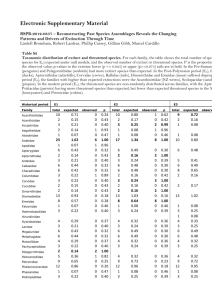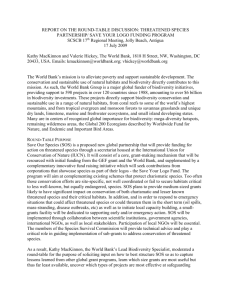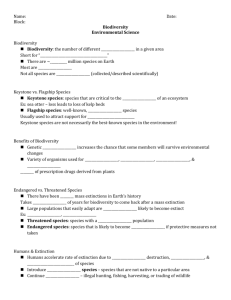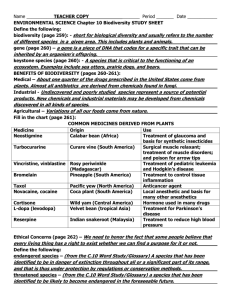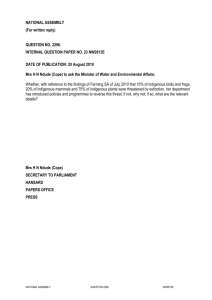Threatened Species and Ecosystems Working Group
advertisement
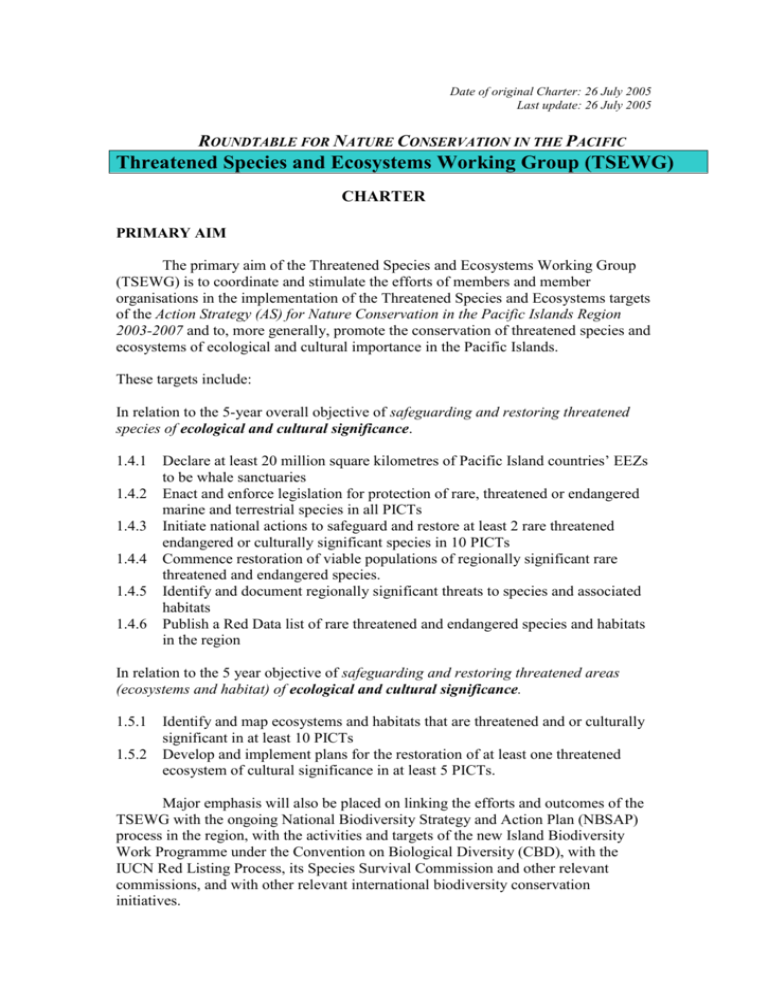
Date of original Charter: 26 July 2005 Last update: 26 July 2005 ROUNDTABLE FOR NATURE CONSERVATION IN THE PACIFIC Threatened Species and Ecosystems Working Group (TSEWG) CHARTER PRIMARY AIM The primary aim of the Threatened Species and Ecosystems Working Group (TSEWG) is to coordinate and stimulate the efforts of members and member organisations in the implementation of the Threatened Species and Ecosystems targets of the Action Strategy (AS) for Nature Conservation in the Pacific Islands Region 2003-2007 and to, more generally, promote the conservation of threatened species and ecosystems of ecological and cultural importance in the Pacific Islands. These targets include: In relation to the 5-year overall objective of safeguarding and restoring threatened species of ecological and cultural significance. 1.4.1 Declare at least 20 million square kilometres of Pacific Island countries’ EEZs to be whale sanctuaries 1.4.2 Enact and enforce legislation for protection of rare, threatened or endangered marine and terrestrial species in all PICTs 1.4.3 Initiate national actions to safeguard and restore at least 2 rare threatened endangered or culturally significant species in 10 PICTs 1.4.4 Commence restoration of viable populations of regionally significant rare threatened and endangered species. 1.4.5 Identify and document regionally significant threats to species and associated habitats 1.4.6 Publish a Red Data list of rare threatened and endangered species and habitats in the region In relation to the 5 year objective of safeguarding and restoring threatened areas (ecosystems and habitat) of ecological and cultural significance. 1.5.1 Identify and map ecosystems and habitats that are threatened and or culturally significant in at least 10 PICTs 1.5.2 Develop and implement plans for the restoration of at least one threatened ecosystem of cultural significance in at least 5 PICTs. Major emphasis will also be placed on linking the efforts and outcomes of the TSEWG with the ongoing National Biodiversity Strategy and Action Plan (NBSAP) process in the region, with the activities and targets of the new Island Biodiversity Work Programme under the Convention on Biological Diversity (CBD), with the IUCN Red Listing Process, its Species Survival Commission and other relevant commissions, and with other relevant international biodiversity conservation initiatives. 2 To achieve these aims there is the priority need to commit ourselves to promoting awareness of island biodiversity, its threatened status, its role as the foundation for all sustainable development in the Pacific Islands, and the associated need, in PICs, to place special emphasis on the preservation, promotion, dissemination, application and synthesis of modern and traditional scientific knowledge (modern and traditional ethnobiodiversity) due to the critical role that local and indigenous knowledge systems (LINKS) and community-based conservation plays in PICs. OBJECTIVES/EXPECTED OUTCOMES In supporting the achievement of these targets the main objectives of the TSEWG (including guiding principles) include: 1. Generating greater activity, within the PICs, to carry out appropriate assessments, at both the national and local levels, of species and ecosystems under threat so that they can be “listed” and respective countries eligible for appropriate funding from IUCN or other appropriate sources. 2. Ensuring that all PICs become more involved with the formal IUCN Redlisting process, acquire funds and list appropriate species. 3. Liaising with IUCN and other relevant bodies on a review of the IUCN Red Listing1 system in view of the increasing focus at IUCN on sustainable livelihoods. 4. Developing a “red list” process’ adapted to a pro forma and methodologies that will allow PICs and local communities to better assess the threatened status of their local biodiversity and to generate “working red lists” of threatened species. This would include adapting red listing, classification and protection intervention procedures to: o the needs of small islands, local communities and resource users o the prevention of the extirpation of local populations as well to the prevention of the global extinction. o endemic and non-endemic species of particular ecological, cultural and economic importance in the region. o the protection of threatened genetic diversity, with particular emphasis on the protection of traditional agrobiodiversity. 1 The intent of the group is to both increase activity in the region to have PICs formally list species and their status under the IUCN Red List AND to develop a regional “red listing” system that is more adaptable to small island states, some of which have few endemics, but where threats to ecologically and culturally important species are currently seen as among the most serious threats to sustainable development and poverty prevention and alleviation in the region. When “Red List” is capitalized, it refers to the IUCN Red List and process; when “red list” is not capitalized it refers to attempts to develop a parallel regional system adapted to the needs of small island states where biodiversity conservation is most effectively be carried out at the community, landowner and resource user levels. 3 5. Vernacularise the redlists and other “lists” and suggested actions arising out of at assessments at the regional, national and local levels. 6. The integration and strengthening of information on TSEs in ongoing and future programme of nature conservation in the Pacific Islands, with particular emphasis on NBSAPs and community-based conservation initiatives. 7. Identification of strategies/tools/models for use at the national, island and local community levels that can facilitate the rapid assessment TSEs. 8. Adapting species conservation strategies to the needs of people who depend on the sustainable use of biodiversity for their cultural, economic and ecological survival. 9. Strengthening the capacity of countries and conservation groups to do risk assessment of different species. 10. Facilitating of the implementation of regional species and ecosystem action plans. 11. Assisting PICs to formally implement appropriate protection and management regimes for selected species and ecosystems under both the IUCN and regional or local red listing regimes. 12. Assisting local conservation areas, MPAs, ICM initiatives, etc. identify critical ecosystems and species and implement protection/management strategies to address the threats. This would include the identification of relevant in-situ and ex-situ actions (e.g., including germ plasm banks, botanical gardens, minizoos, small forest reserves, village tree groves, MPAs, etc.) for threatened species protection. 13. Ensuring that politicians, church groups, private enterprise, school children and the general public are better informed about threatened species and ecosystems and the global crisis affecting island biodiversity. 14. Preparation of information about different threatened species or groups of species, ecosystems and ecosystem functions that can be used in regional and national media and in schools. 15. Increase awareness at all levels within the Pacific Islands of threatened species and associated threats as a basis for generating positive responses to the global extinction and local extirpation crises. TARGETS/ACTIONS (2005-2007) To achieve these objective/outcomes the following targets/actions (with persons and target dates) have been identified (It is stressed that this is only a provisional first list and that all interested parties are encouraged to make new or 4 additional commitments or agree to work with those persons listed as currently responsible for the actions listed below: 1. Formally establish the TSEWG, establish a “Core Group” (roster of experts), set up an E-Group and finalise a “living” Working Charter and hold quarterly Emeetings (TSEWG)(September 2005). 2. Compile a list of people working on endangered species in the Pacific Islands (R. Thaman and G. Kula to work with IUCN)(Dec. 2005). 3. Establish formal links the IUCN Species Survival Commission groups to attempt to have greater engagement in PICs (Randy, Milika Sobey-Naqasimato through IUCN Pacific Office and through the IUCN World conservation Learning Network/WCLN)(June 2006). 4. Adapt the IUCN Redlist and other systems of identification and classification of threatened species and ecosystems (TSEs) to the needs of small islands and community-based conservation, sustainable use and equitable sharing of biodiversity, the three main objectives of the Convention on Biological Diversity (CBD). More specifically, to develop a classification system of levels of threat, listing and means of assessment that: o Is more suited to the needs of small islands and local communities and to the stated targets of the AS, which stipulate “species and ecosystems” of “cultural and ecological importance”. o focuses more on the protection and management of viable local populations of cultural and ecological importance rather than only on endemics and global extinction o focuses on both native and threatened cultivated and wild introduced species o stresses the balance between the protection of threatened species and threatened ecosystems and ecosystem processes and interconnectivity o better defines what is meant by culturally and ecologically important species. (e.g, fleshes out a classification of cultural importance, e.g. totems, fragrant plants, medicinal plants, firewood plants, etc.) o can be used to assess conservation priorities at the regional, national and community and local small island levels (R. Thaman, Gai Kula Neneteit Ruatu(First Draft by June 200) 5. Work through NBSAP and other relevant persons to determine the progress to date in reaching the species and ecosystems targets of the AP, the status of each country in terms of IUCN Red Listing for PICTs (ESEWG; Liz, Kate – SPREP; Randy – USP, Gai Kula – CI, NBSAPs, Nenteiti - Kiribati)(June 2006). 6. Distribute the CI Inventory of Threatened Species and Ecosystems in Polynesia and Micronesia to all RT Members and BSAPs (Gai Kula, CI, Randy to contact Francoise Martel)(Dec 2005). 7. Prepare a paper to promote national and community awareness of the concepts of endemism, endemics, and threatened status of unique endemic species as a basis for achieving a balance between the protection of culturally important and rare or 5 endemic species and to promote national pride in unique endemic species (Randy, Ana Tiraa, Nenteiti to draft and distribute to WG and NBSAPs)(June 2006). 8. Assist PICTs in their efforts to implement the relevant aspects of their NBSAPs or equivalent documents (TSEWG, Kate-SPREP and NBSAP)(ongoing). 9. Develop a “red listing” system for the adaptation to GIS models, gap analyses and spatial biodiversity analysis (e.g., use of GPS) tools for use at the local island community/resource owner levels (Nick Rollings, USP-GIS; James Atherton WCS)(Dec. 2006). 10. Collation of a Pacific Islands regional working list of threatened species and photographs that can be distributed to all NBSAPs, RT members and other relevant interested parties. This would entail collaboration with NBSAP and collation of data from NBSAPS, the Red List and other sources. The goal is to have 10 Countries submit working lists of threatened species and ecosystems for compilation into a regional “redlist” “inventory” of threatened species at the regional, national and community level. This would include contacting those countries with existing data bases and sharing information on threatened species (TSEWG; Pacific Biodiversity Information Forum/Pacinet, NBSAPS, TSEWG, USP, SPREP, SPC; CRISP – Eric Clua/ to contact Procfish/SPC, Cook Islands – Elizabeth Munro, CI PNG – Guy to work which David Mitchell, Roger James, USP – Randy Thaman, Marika Tuiwawa (Dec. 2006). 11. Distribute a Working List of Priority Taxa and Associated Threats with columns for ID down to the species level and country/location data. This would include species ecologically and culturally important species that are seen as threatened or seriously declining at the community level. (R. Thaman – USP; Nenteiti Ruatu)(Dec. 2005). 12. Produce a working summary of the major threats and how they are linked to threatened species (R. Thaman – USP)(Dec. 2005). 13. Monitor the Bird Conservation Strategy and adapt to objectives of the AP through a Bird Conservation Working Group that has been established under this working group. This would include the revision of the Bird Conservation Strategy so that it more closely links with the AS (Liz Dovey, Ana Tiraa, Don Stewart and the Bird Group (Mid- 2006). 14. Develop and implement management plans for the protection of two species in PNG (Gai Kula, CI to follow up)(Dec. 2006) 15. Commitment to do a risk status of sharks in the Pacific Islands (CRISP/Eric Clua)(December 2006, preliminary report). 16. Update the compilation of pandanus cultivars, including listing of threatened cultivars and develop a pandanus management plan for Kiribati (Neneteiti Ruatu in conjunction with Agriculture Division)(Dec 2006). 6 17. Study on the status and develop a working plan for the recovery of agrobiodiversity in Tonga (Kulaea Kilisimasi - Tonga). 18. Refinement and implementation of a management plant for the propogaton and distribution of heilala (Garcinia sessilis), the threatened chiefly national flower of Tonga (Kulaea Kilisimasi). 19. Improve knowledge in the region of the threatened status of many of our terrestrial, freshwater and marine taxa and ecosystems, including agricultural biodiversity and other non-indigenous biodiversity in Tuvalu, Kiribati, Cook Islands, Tonga and Fiji. (Kulaiea Kilisimati – Tonga; Enate Evi – Tuvalu, Elizabeth Munro and Ana Tiraa – Cook Islands, Nenenteiti Ruatu Kiribati)(Mid-2006). 20. Produce and inventory on links between ecotourism/tourism and the protection of TSEs as part of their ongoing programmes of tourism operatives (CRISP – Randy Thaman)(December 2006). 21. Hold a series of national/in-country or subregional workshops to Develop Capacity for Species Risk assessment and implementing actions to protect and manage threatened species in conjunction with USP, IUCN Pacific, SPREP, NBSAPs (Working Group/Randy and Gai Kula to contact IUCN-Pacific in collaboration with SPREP)(by June 2007) COMMUNICATION METHODS/WAYS TO MAKE IT WORK Have mandatory monthly or quarterly e-group “meetings” Provide written records Try to have two yearly face-to-face meetings of some members (opportunistic meeting associated with other meetings/back-to-back meetings) Conference calls 7 Threatened Species and Ecosystems Working Group Membership and Meeting Attendance Organisation Primary representative TSEWG Meetings attended Other representatives/ alternates ISWG Meetings attended 8

